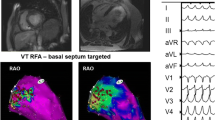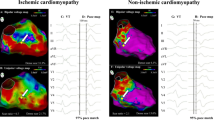Abstract
Background
Sustained ventricular tachycardia (VT) in patients with nonischemic cardiomyopathy (NICM) often involves midmyocardial and epicardial structures. Delayed-enhancement magnetic resonance imaging (DE-MRI) of scar and fibrosis is the method of choice to define the substrate of monomorphic VT.
Objective
The aim of the study was to compare the outcome of endocardial vs. epicardial VT ablation in patients with epicardial DE-MRI substrates in NICM.
Results
Among 44 patients with NICM referred for VT ablation who underwent DE-MRI, 12 patients had an epicardial-only (n = 4) or predominantly epicardial DE-MRI substrate (n = 8). 9 of the 12 patients had a prior myocarditis. Endocardial-only VT ablation was successful in two patients with epicardial DE-MRI substrate. A pericardial access for epicardial mapping and ablation was attempted in 8 patients and could be accomplished in seven. Epicardial low voltage (<1.5 mV) and very low voltage (<0.5 mV) areas were in good qualitative correlation to the epicardial DE-MRI substrates. Epicardial abnormal electrograms in combination with a good pace map QRS match were found in epicardial very low voltage areas in five patients and in low voltage areas in two patients. 2 patients with endocardial-only ablation, five patients with endo-epicardial ablation and two patients with primary epicardial ablation had a favorable post-ablation outcome (follow-up 32 ± 26 months) but one patient had to undergo heart transplantation for heart failure deterioration.
Conclusions
Endo-epicardial ablation or primary epicardial ablation should early be considered in patients after myocarditis or with other forms of nonischemic cardiomyopathy with epicardial DE-MRI substrates.






Similar content being viewed by others
References
Hsia HH, Callans DJ, Marchlinski FE (2003) Characterization of endocardial electrophysiological substrate in patients with nonischemic cardiomyopathy and monomorphic ventricular tachycardia. Circulation 108:704–710
Soejima K, Stevenson WG, Sapp JL, Selwyn AP, Couper G, Epstein LM (2004) Endocardial and epicardial radiofrequency ablation of ventricular tachycardia associated with dilated cardiomyopathy: the importance of low-voltage scars. J Am Coll Cardiol 43:1834–1842
Cano O, Hutchinson M, Lin D, Garcia F, Zado E, Bala R, Riley M, Cooper J, Dixit S, Gerstenfeld E, Callans D, Marchlinski FE (2009) Electroanatomic substrate and ablation outcome for suspected epicardial ventricular tachycardia in left ventricular nonischemic cardiomyopathy. J Am Coll Cardiol 54:799–808
Karamitsos TD, Francis JM, Myerson S, Selvanayagam JB, Neubauer S (2009) The role of cardiovascular magnetic resonance imaging in heart failure. J Am Coll Cardiol 54:1407–1424
Heidary S, Patel H, Chung J, Yokota H, Gupta SN, Bennett MV, Katikireddy C, Nguyen P, Pauly JM, Terashima M, McConnell MV, Yang PC (2010) Quantitative tissue characterization of infarct core and border zone in patients with ischemic cardiomyopathy by magnetic resonance is associated with future cardiovascular events. J Am Coll Cardiol 55:2762–2768
Nazarian S, Bluemke DA, Lardo AC, Zviman MM, Watkins SP, Dickfeld TL, Meininger GR, Roguin A, Calkins H, Tomaselli GF, Weiss RG, Berger RD, Lima JAC, Halperin HR (2005) Magnetic resonance assessment of the substrate for inducible ventricular tachycardia in nonischemic cardiomyopathy. Circulation 112:2821–2825
Bogun FM, Desjardins B, Good E, Gupta S, Crawford T, Oral H, Ebinger M, Pelosi F, Chugh A, Jongnavangsin K, Morady F (2009) Delayed-enhanced magnetic resonance imaging in nonischemic cardiomyopathy: utility for identifying the ventricular arrhythmia substrate. J Am Coll Cardiol 53:1138–1145
Koch J, Arya A, Hindricks G, Eitel C (2015) Cardiac magnetic resonance imaging reveals extensive biventricular fibrosis and inflammation challenging the diagnosis of ARVC. Clin Res Cardiol 104:700–703
Scott PA, Morgan JM, Carroll N, Murday DC, Roberts PR, Peebles CR, Harden SP, Curzen NP (2011) The extent of left ventricular scar quantified by late gadolinium enhancement MRI is associated with spontaneous ventricular arrhythmias in patients with coronary artery disease and implantable cardioverter-defibrillator. Circ Arrhythm Electrophysiol 4:324–330
Berte B, Sacher F, Cochet H, Mahida S, Yamashita S, Lim H, Denis A, Derval N, Hocini M, Haissaguerre M, Jais P (2015) Postmyocarditis ventricular tachycardia in patients with epicardial-only scar: a specific entity requiring a specific approach. J Cardiovasc Electrophysiol 26:42–50
Aliot EM, Stevenson WG, Almendral-Garrote JM, Bogun F, Calkins CH, Delacretaz E, Della Bella P, Hindricks G, Jais P, Josephson ME, Kautzner J, Kay GN, Kuck KH, Lerman BB, Marchlinski F, Reddy V, Schalij MJ, Schilling R, Soejima K, Wilber D, European Heart Rhythm Association, Registered Branch of the European Society of Cardiology, Heart Rhythm Society, American College of Cardiology, American Heart Association (2009) EHRA/HRS Expert consensus on catheter ablation of ventricular arrhythmias: developed in a partnership with the European Heart Rhythm Association (EHRA), a registered branch of the European Society of Cardiology (ESC) and the Heart Rhythm Society (HRS); in collaboration with the American College of Cardiology (ACC) and the American Heart Association (AHA). Heart Rhythm 6:866–933
Sosa E, Scanavacca M, D’Avila A, Pilleggi F (1996) A new technique to perform epicardial mapping in the electrophysiology laboratory. J Cardiovasc Electrophysiol 7:531–536
Reithmann C, Hahnefeld A, Remp T, Steinbeck G (2007) Ventricular tachycardias with participation of the left bundle-Purkinje system in patients with structural heart disease: identification of slow conduction during sinus rhythm. J Cardiovasc Electrophysiol 18:808–817
Reithmann C, Fiek M, Hahnefeld A, Ulbrich M, Steinbeck G (2012) Recording of low-amplitude diastolic electrograms through the coronary veins: a guide for epicardial ventricular tachycardia ablation. Europace 14:865–871
Mahrholdt H, Goedecke C, Wagner A, Meinhardt G, Athanasiadis A, Vogelsberg H, Fritz P, Klingel K, Kandolf R, Sechtem U (2004) Cardiovascular magnetic resonance assessment of human myocarditis: a comparison to histology and molecular pathology. Circulation 109:1250–1258
Maccabeli G, Tsiachris D, Silberbauer J, Esposito A, Biscegllia C, Baratto F, Colantonin C, Trevisi N, Palmisano A, Vergara P, DeCobelli F, Del Maschio A, Della Bella P (2014) Imaging and epicardial substrate ablation of ventricular tachycardia in patients late after myocarditis. Europace 16:1363–1372
Dello RA, Casella M, Pieroni M, Pelargonio G, Bartoletti S, Santangeli P, Zucchetti M, Innocenti E, DeBiase L, Carbucicchio C, Bellocci F, Fiorentini C, Natale A, Tondo C (2012) Drug-refractory ventricular tachycardias following myocarditis: endocardial and epicardial radiofrequency catheter ablation. Circ Arrhythm Electrophysiol 5:492–498
Komatsu Y, Daly M, Sacher F, Cochet H, Denis A, Derval N, Jesel L, Zellerhoff S, Lim HS, Jadidi A, Nault I, Shah A, Roten L, Pascale P, Scherr D, Aurillac-Lavignolle V, Hocini M, Haissaguerre M, Jais P (2014) Endocardial ablation to eliminate epicardial arrhythmia substrate in scar-related ventricular tachycardia. J Am Coll Cardiol 63:1416–1426
Cochet H, Komatsu Y, Sacher F, Jadidi AS, Scherr D, Riffaud M, Derval N, Shah A, Roten L, Pascale P, Relan J, Sermesant M, Ayache N, Montaudon M, Laurent F, Hocini M, Haissaguerre M, Jais P (2013) Integration of merged delayed-enhanced magnetic resonance imaging and multidetector computed tomography for the guidance of ventricular tachycardia ablation: a pilot study. J Cardiovasc Electrophysiol 24:419–426
Author information
Authors and Affiliations
Corresponding author
Rights and permissions
About this article
Cite this article
Reithmann, C., Herkommer, B. & Fiek, M. Epicardial ventricular tachycardia substrate visualized by magnetic resonance imaging: need for a transpericardial ablation approach?. Clin Res Cardiol 105, 827–837 (2016). https://doi.org/10.1007/s00392-016-0990-0
Received:
Accepted:
Published:
Issue Date:
DOI: https://doi.org/10.1007/s00392-016-0990-0




